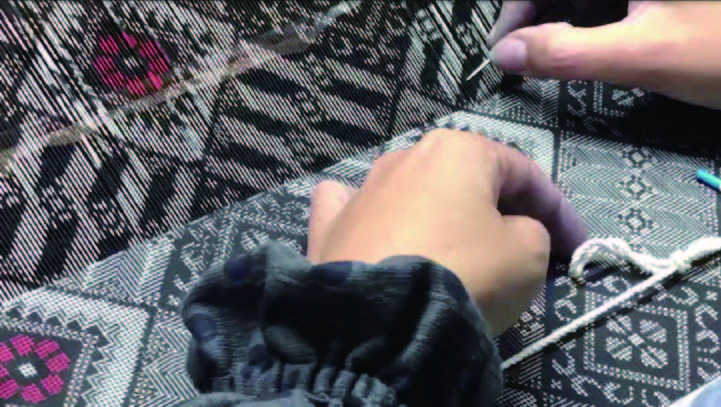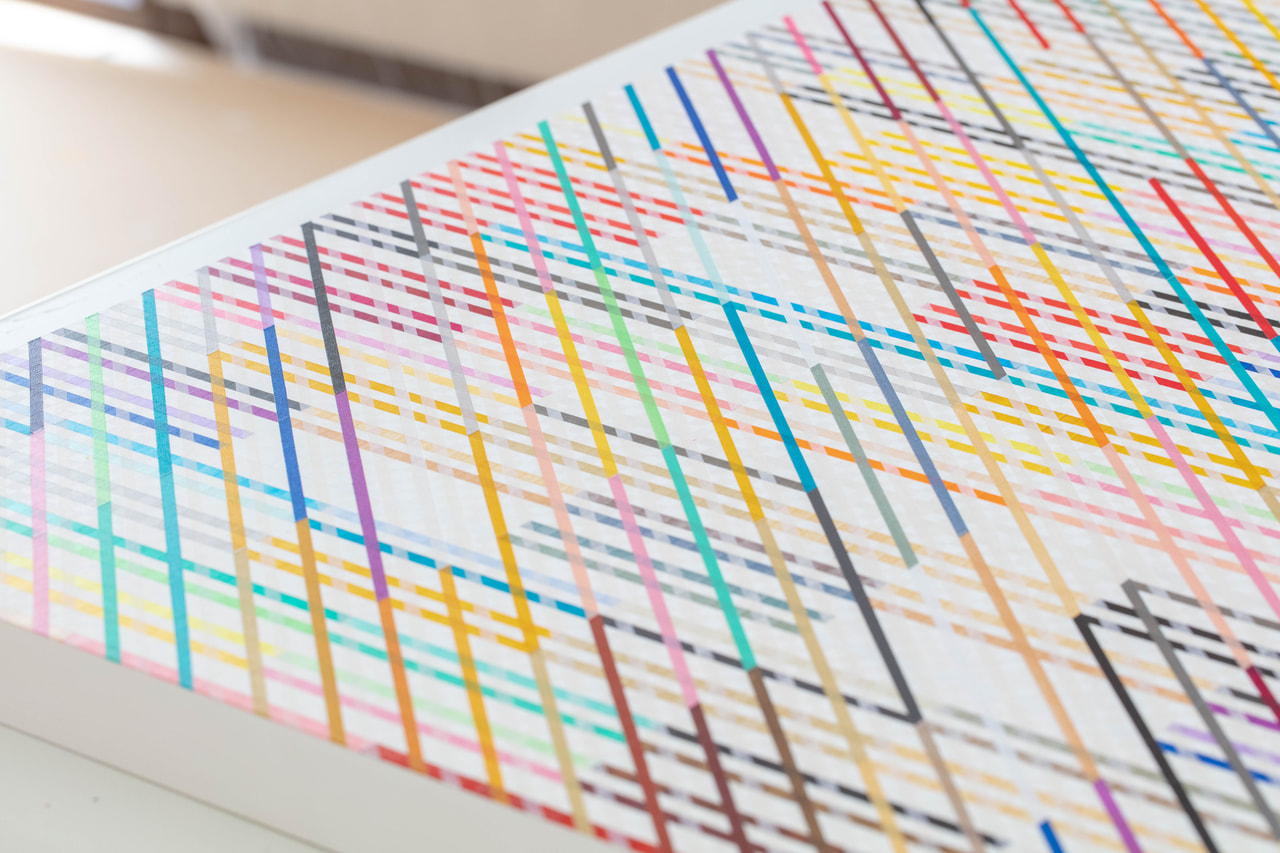Imura Art Gallery is pleased to announce “織(Ori)Scopic,” a solo exhibition by Aya Kawato and her first in Japan in 3 years.
Since she was a small child, Aya Kawato has been influenced by her neuroscientist father. This influence fostered an awareness that the world is perceived through the brain, and made her particularly interested in optical illusions. After studying textiles as an undergraduate in Kyoto, Kawato sought out different methods of expression and arrived at her current grid painting style which expresses themes of control and imperfection. Her visual practices focuses on forming an empathetic connection with the viewer regarding the existence of areas beyond the reach of human knowledge and created through these moments of imperfection.
Kawato has based her practice on the words of Soetsu Yanagi (1889-1961), an advocate of the mingei (folk craft) movement, who wrote in Bashofu Monogatari, “The beauty of kasuri textiles lies precisely in the fact that the patterns contain imperfections within them.” With this concept of “kasuri style” imperfection in mind, Kawato recognized that the imperfect kasuri textiles hold a beauty that reflects the limits of intentional expression and has incorporated this idea into her own creative process.
This exhibition will feature 12 new works which contain 45 degree diagonal lines layered into Kawato’s usual grid compositions. Wallpaper will also be used alongside these paintings to create an immersive, fluctuating installation experience for viewers as they move throughout the exhibition space. We hope you’ll take advantage of this opportunity and come experience the work for yourself.
reference: Kawato, Aya. 2018. ‘Researching structures of control and imperfection in Oshima Tsumugi textiles.’ Tokyo University of the Arts, Tokyo.
−Artist Statement
A few months ago I contacted Mr. Hajime, an Oshima Tsumugi textile manufacturer, and asked him to send me a video of the textile creation process. Mr. Hajime was an invaluable help to me during my PhD studies when I was researching the structures of control and imperfection in Oshima Tsumugi textile production. When I contacted him for images of this delicate weaving process, Mr. Hajime sent me a video of a technique called kasuri awase.
I watched the video as soon as I received it. While I was struck by the intricate kasuri awase process, what attracted me most was the beauty of the vertical warp threads that had not yet been woven together with the horizontal weft threads.
These dyed warp threads created an unfinished pattern which I unconsciously began to complete. Humans have a perceptual tendency to fill in the gaps in incomplete patterns, and I found myself enjoying the way my mind was creating the image on the cloth as it was being woven. Inspired by this, I decided to create a series of paintings with 45-degree diagonal lines overlapping perpendicular ones.
 photograph courtesy of Hajime Shoji
photograph courtesy of Hajime Shoji
織Scopic
The character “織” is pronounced “ori” and means “weave.” The suffix “-scopic” is taken from macroscopic, mesoscopic, and microscopic. These latter 3 are important keywords for my work because they express the ways in which my paintings shift and change depending on large, mid-range, or short viewing distances.
As you examine the work in this show from different distances and angles, I hope you enjoy the shifts that occur in the image through the innumerable perpendicular and diagonal lines that have been individually divided and painted. I want you to look at the threads that have not yet been woven and imagine a textile that only you can see.
Through an 織Scopic way of seeing, I hope you are able to find enjoyment in both work and space alike.
*In order to prevent the spread of COVID-19 infection, we would appreciate your cooperation for the following precautions.
・All visitors are asked to wear masks.
・Please refrain from visiting if you have symptoms such as colds or fever.
・If the inside of the gallery is crowded, you may have to wait at the entrance.
*For those who do not come because of distance.
If you have any questions about works, please feel free to contact us.
イムラアートギャラリーでは、このたび、日本では3年ぶりとなる川人綾の個展「織(Ori) Scopic」を開催いたします。
川人は幼い頃から神経科学者の父から影響を受けて、脳を通して世界を把握していると意識するようになり、特に錯視効果に興味を持ちます。学部時代に京都で染織を学んだ後、表現方法を追求し、「制御とズレ(Controlled and Uncontrolled)」をテーマとした現在のグリッドペインティングの手法へとたどりつきました。「ズレ」がもたらす人知の及ばない領域の存在を鑑賞者と共感するために、作品を創り続けています。
川人は、民藝運動の主唱者である柳宗悦(1889-1961)の『芭蕉布物語』における“絣(かすり) の美しさは實に模樣が「ずれ」を有つてゐることによるのです。”といった「絣味」と題された「ずれ」への言及を参考に、「ズレ」を持つ絣には、意図的に表現しようとしたものには、決して到達できないような美しさがあるのだと考え、自身の制作に取り込みます。
本展では、これまでのグリッドに斜め45 度の線の重なりが試みられた新作12 点に加えて、壁紙を使用したインスタレーション形式で展覧いたします。観者は展示空間への出入りにより、作品による揺らぎを体感する事ができるでしょう。ぜひ会場でご高覧ください。
―作家ステイトメント
数ヶ月前、とある理由で、大島紬織元の元さんに、大島紬の製造工程の動画を送っていただいた。元さんは、私が博士課程で大島紬における制御とズレの構造について研究していた頃に、とてもお世話になった方だ。大島紬の精緻に織っていく製作工程の映像をリクエストしたところ、元さんは絣合わせという工程の動画を送ってくださった。
さっそく動画を拝見して、絣合わせの繊細な作業もさることながら、まだ緯糸が織り込まれていない、経糸が交互に上下している状態の美しさに強く惹かれた。まだ緯糸が織り込まれていない染め分けられた経糸が、完成されていない模様を浮かび上がらせている。人には、不完全な視覚パターンに存在する隙間を埋めようとする知覚傾向があるが、これから織られるであろう布のイメージを無意識につくりあげているようで心地良かった。この様子からインスピレーションを受けて、垂直の線と斜め45度の線が重なる絵画を描くことにした。
画像提供:はじめ商事
織Scopic
「scopic」という接尾辞は、下記の3つの単語からとった。
macroscopic = 巨視的な見方
mesoscopic = macroscopic とmicroscopic の中間的な見方
microscopic = 微視的な見方
この3つは、私の作品において大切なキーワードである。遠距離、中距離、近距離から見た作品が移り変わる様を表している。この展覧会では、塗り分けられた無数の垂直と斜め45度の重なる線を、色々な距離や角度から見て、移り変わるイメージを楽しんで欲しい。まだ織り合わされていない糸を見て、あなたにしか見えない布を想像して欲しい。
織Scopic という見方で作品と空間を楽しんで欲しい。
※新型コロナウィルス感染拡大防止のため、ご来廊の皆様へお知らせとお願いです。
・すべての方にマスクの着用をお願いしております。
・風邪や発熱などの症状のある方は来廊をお控えください。
・ギャラリー内が混み合う場合には、入り口でお待ちいただく場合がございます。
※遠方でご来廊いただけない皆様へ
作品のお問合せを承っております。ぜひお気軽にご連絡くださいませ。





